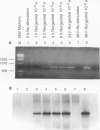Abstract
We have recently reported that about 30-40% of female breast tumours produce prostate-specific antigen (PSA) and that PSA production is associated with the presence of oestrogen (ER) and progesterone (PR) receptors. We have now developed a tissue culture system to study the regulation of the PSA gene in breast cancer. The breast carcinoma cell line T-47D produces PSA when stimulated by androgens, progestins and glucocorticoids/mineralocorticoids but not oestrogens. PSA mRNA appears approximately 2 h after stimulation; PSA protein appears after 4-8 h. Among 38 compounds tested, only androgens and progestins were able to stimulate PSA production at concentrations below 10(-9) M. Evidence that the progesterone and androgen receptors can regulate the PSA gene independently was provided as follows: (a) the progestin norgestimate, which does not bind to the androgen receptor, up-regulates the PSA gene at concentrations as low as 10(-10) M; (b) triamicinolone acetonide, which does not bind to the androgen receptor (AR) but binds to the PR, acts similarly to norgestimate; (c) the antiandrogen cyproterone acetate, which blocks the androgen receptor but has progestational activity, up-regulates the PSA gene at concentrations as low as 10(-10) M; (d) the antiprogestine mifepristone completely blocks the stimulation of the specific progestin norgestimate. Our tissue culture system identified androgen-progestin agonist activities of 17 alpha-ethinyloestradiol, the antioestrogen RU56, 187 and the antiprogestin mifepristone. Our data suggest that the expression of the PSA gene in the female breast is under the control of androgens and progestins. Our tissue culture system is a highly sensitive in vitro method for evaluating the biological activity of candidate compounds having agonist and antagonist steroid hormone activity.
Full text
PDF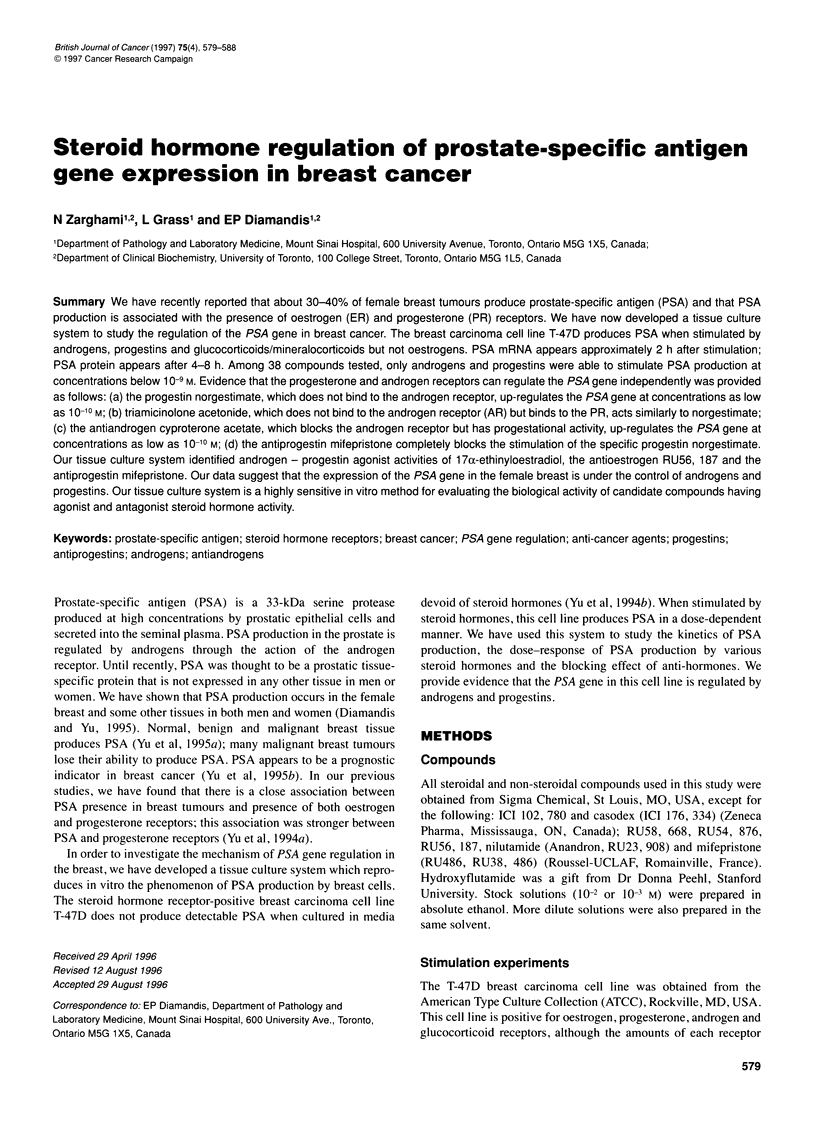
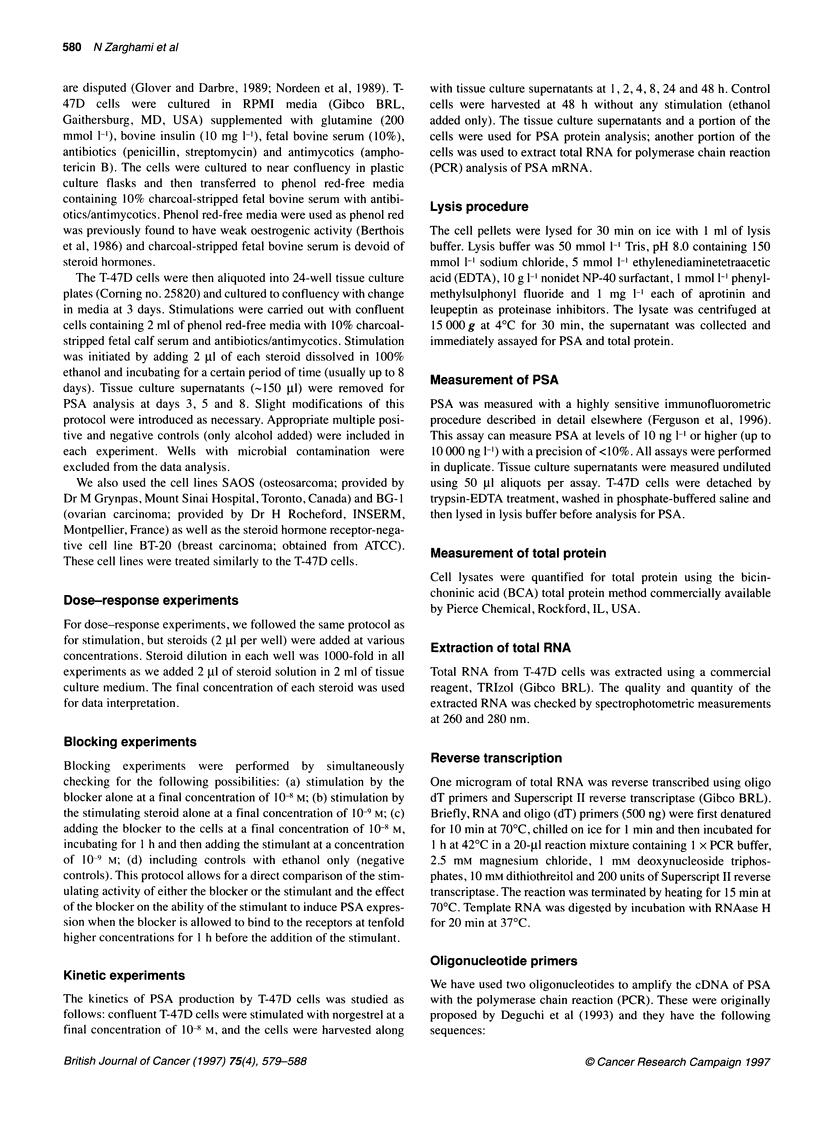
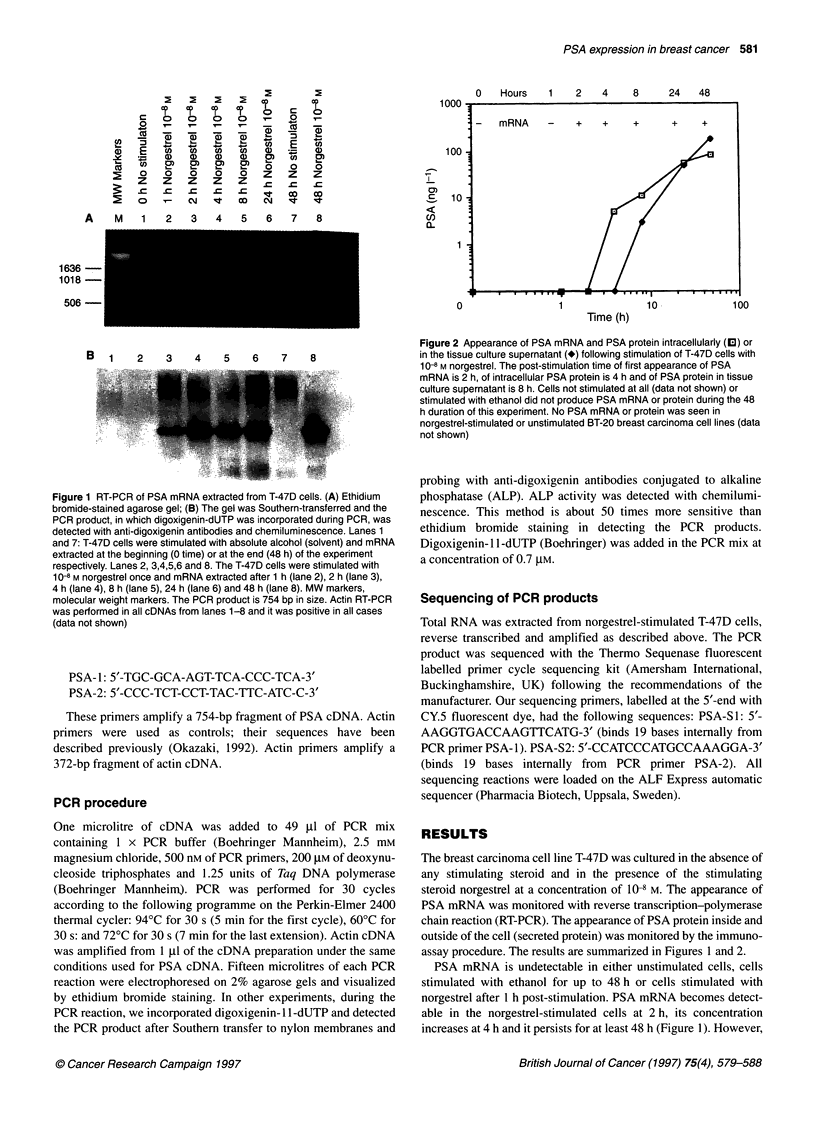
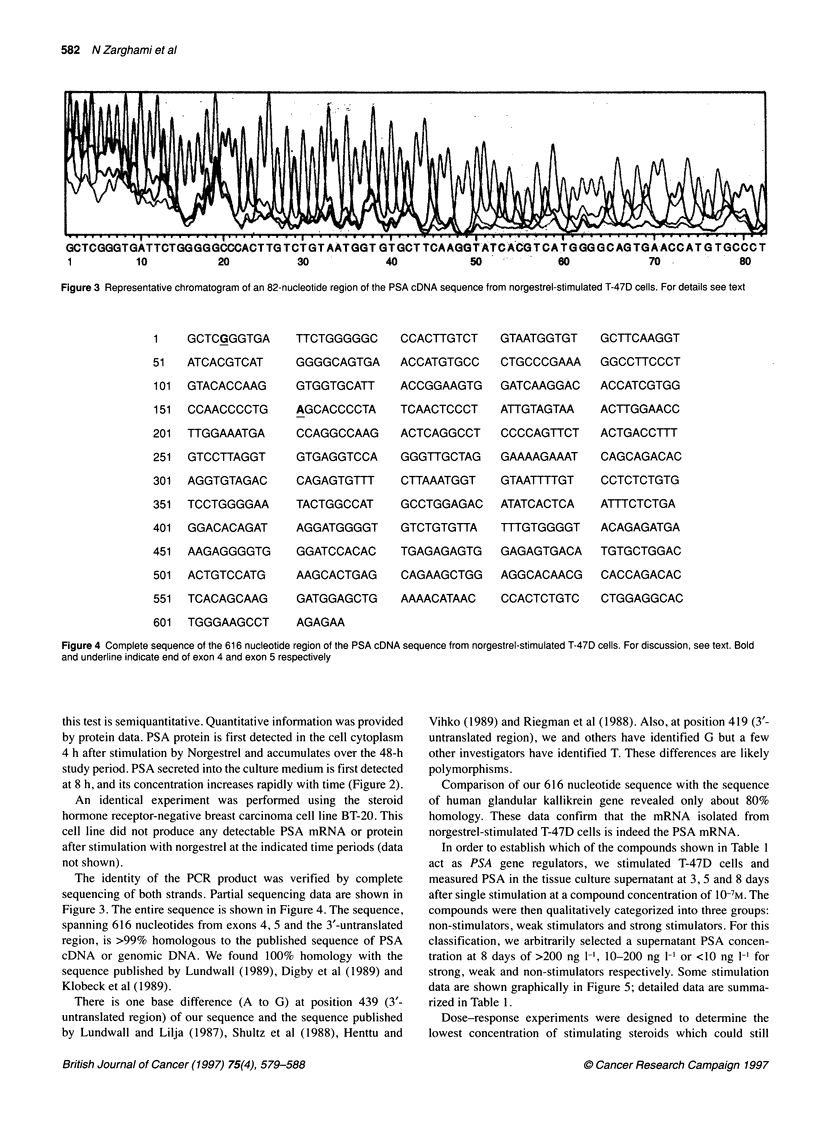

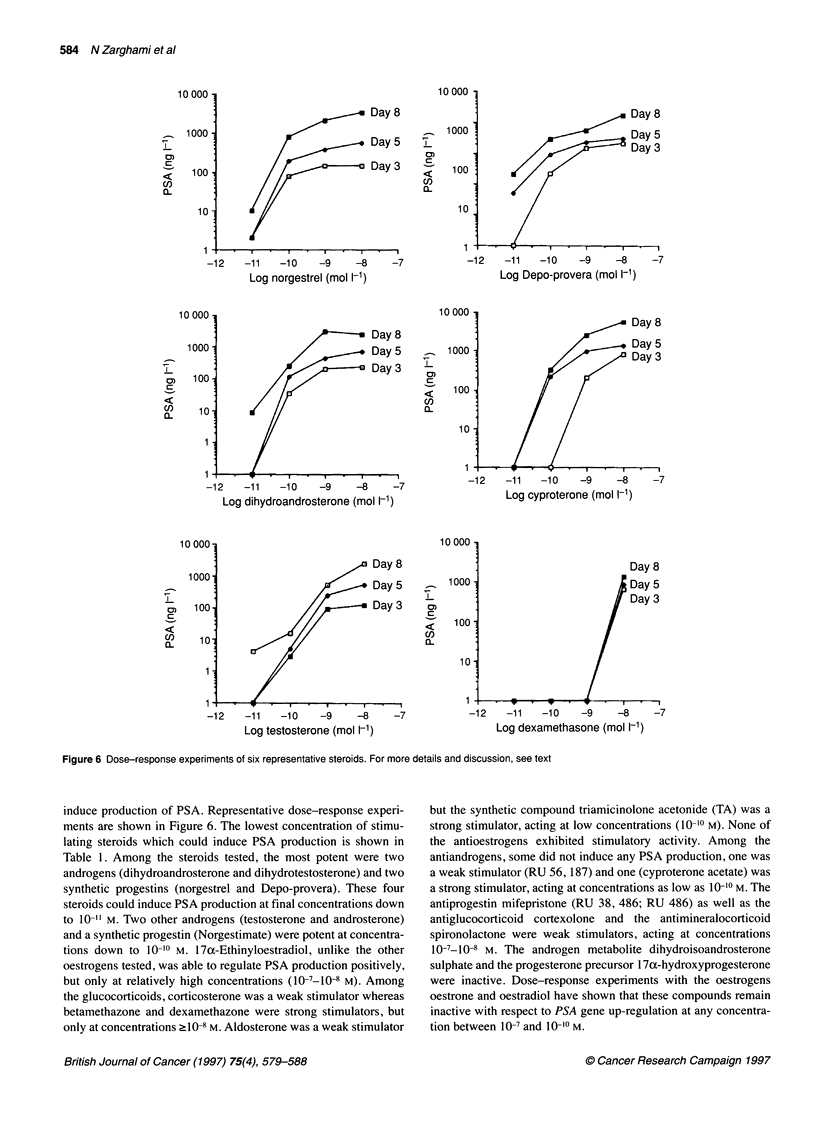
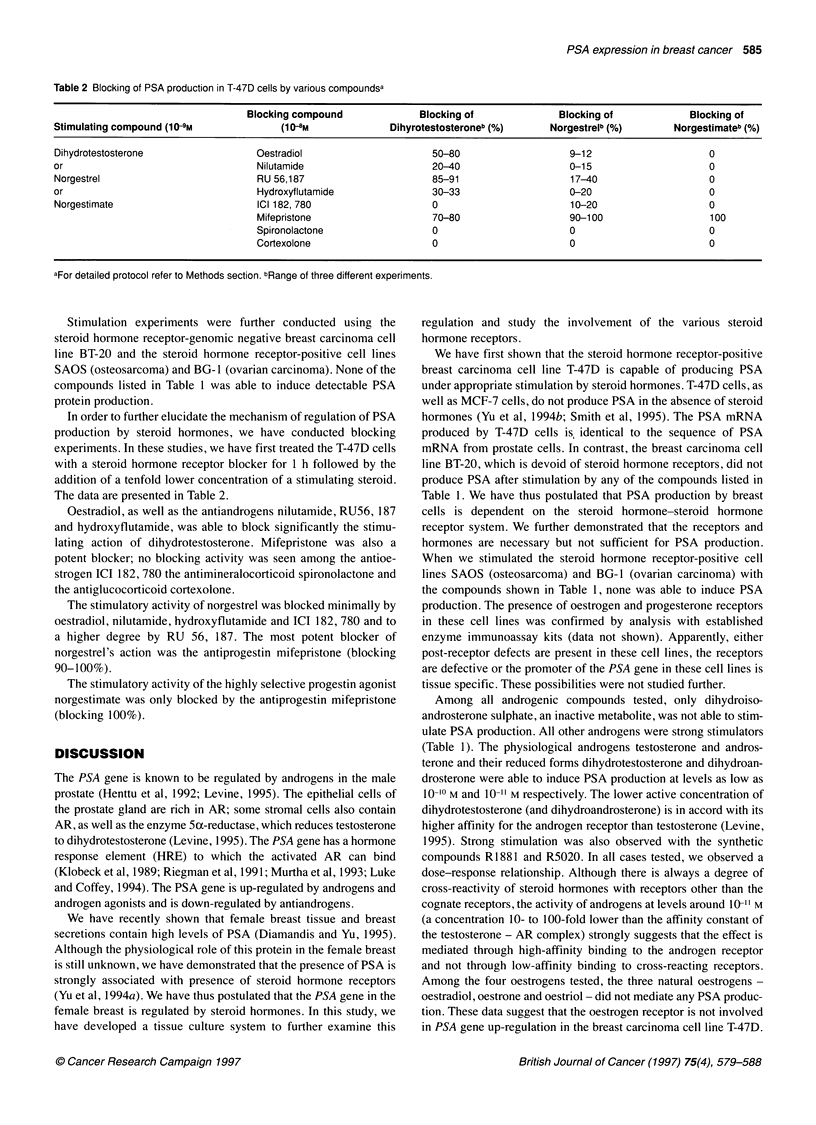
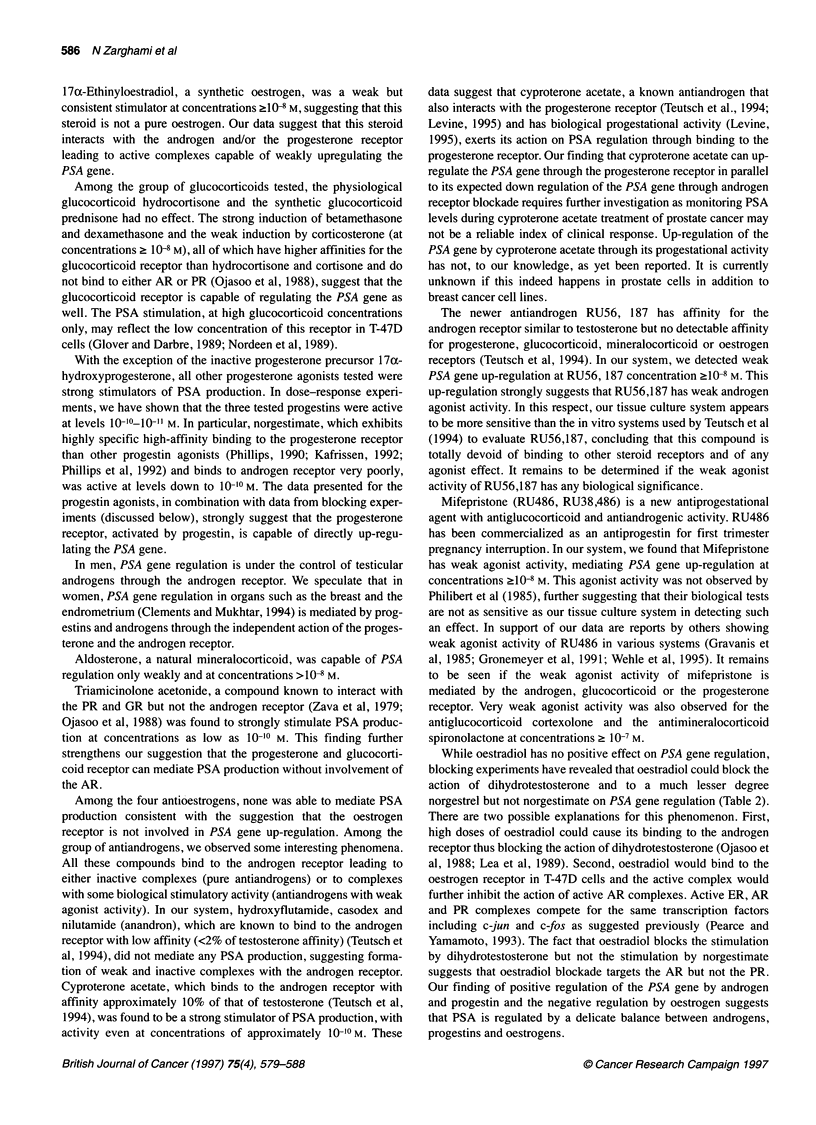
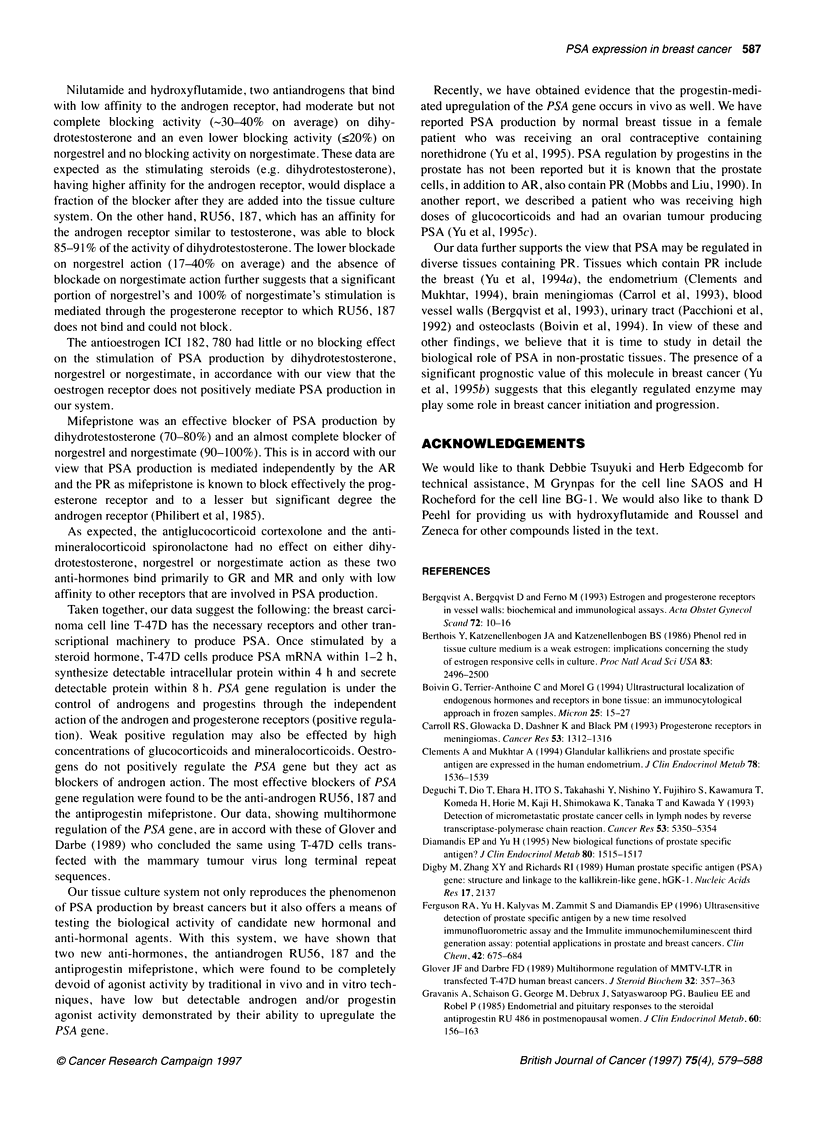
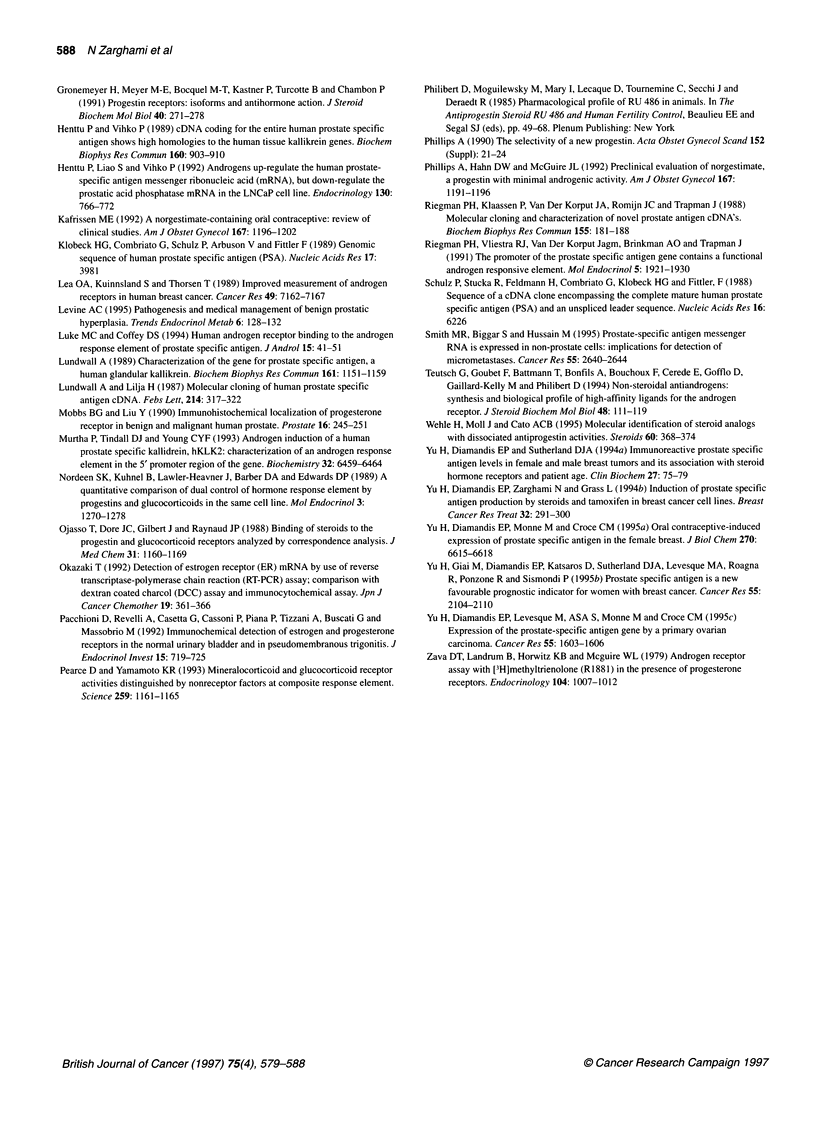
Images in this article
Selected References
These references are in PubMed. This may not be the complete list of references from this article.
- Bergqvist A., Bergqvist D., Fernö M. Estrogen and progesterone receptors in vessel walls. Biochemical and immunochemical assays. Acta Obstet Gynecol Scand. 1993 Jan;72(1):10–16. doi: 10.3109/00016349309013341. [DOI] [PubMed] [Google Scholar]
- Berthois Y., Katzenellenbogen J. A., Katzenellenbogen B. S. Phenol red in tissue culture media is a weak estrogen: implications concerning the study of estrogen-responsive cells in culture. Proc Natl Acad Sci U S A. 1986 Apr;83(8):2496–2500. doi: 10.1073/pnas.83.8.2496. [DOI] [PMC free article] [PubMed] [Google Scholar]
- Boivin G., Anthoine-Terrier C., Morel G. Ultrastructural localization of endogenous hormones and receptors in bone tissue: an immunocytological approach in frozen samples. Micron. 1994;25(1):15–27. doi: 10.1016/0968-4328(94)90052-3. [DOI] [PubMed] [Google Scholar]
- Carroll R. S., Glowacka D., Dashner K., Black P. M. Progesterone receptor expression in meningiomas. Cancer Res. 1993 Mar 15;53(6):1312–1316. [PubMed] [Google Scholar]
- Diamandis E. P., Yu H. New biological functions of prostate-specific antigen? J Clin Endocrinol Metab. 1995 May;80(5):1515–1517. doi: 10.1210/jcem.80.5.7538144. [DOI] [PubMed] [Google Scholar]
- Digby M., Zhang X. Y., Richards R. I. Human prostate specific antigen (PSA) gene: structure and linkage to the kallikrein-like gene, hGK-1. Nucleic Acids Res. 1989 Mar 11;17(5):2137–2137. doi: 10.1093/nar/17.5.2137. [DOI] [PMC free article] [PubMed] [Google Scholar]
- Ferguson R. A., Yu H., Kalyvas M., Zammit S., Diamandis E. P. Ultrasensitive detection of prostate-specific antigen by a time-resolved immunofluorometric assay and the Immulite immunochemiluminescent third-generation assay: potential applications in prostate and breast cancers. Clin Chem. 1996 May;42(5):675–684. [PubMed] [Google Scholar]
- Glover J. F., Darbre P. D. Multihormone regulation of MMTV-LTR in transfected T-47-D human breast cancer cells. J Steroid Biochem. 1989 Mar;32(3):357–363. doi: 10.1016/0022-4731(89)90207-0. [DOI] [PubMed] [Google Scholar]
- Gravanis A., Schaison G., George M., de Brux J., Satyaswaroop P. G., Baulieu E. E., Robel P. Endometrial and pituitary responses to the steroidal antiprogestin RU 486 in postmenopausal women. J Clin Endocrinol Metab. 1985 Jan;60(1):156–163. doi: 10.1210/jcem-60-1-156. [DOI] [PubMed] [Google Scholar]
- Gronemeyer H., Meyer M. E., Bocquel M. T., Kastner P., Turcotte B., Chambon P. Progestin receptors: isoforms and antihormone action. J Steroid Biochem Mol Biol. 1991;40(1-3):271–278. doi: 10.1016/0960-0760(91)90192-8. [DOI] [PubMed] [Google Scholar]
- Henttu P., Liao S. S., Vihko P. Androgens up-regulate the human prostate-specific antigen messenger ribonucleic acid (mRNA), but down-regulate the prostatic acid phosphatase mRNA in the LNCaP cell line. Endocrinology. 1992 Feb;130(2):766–772. doi: 10.1210/endo.130.2.1370795. [DOI] [PubMed] [Google Scholar]
- Henttu P., Vihko P. cDNA coding for the entire human prostate specific antigen shows high homologies to the human tissue kallikrein genes. Biochem Biophys Res Commun. 1989 Apr 28;160(2):903–910. doi: 10.1016/0006-291x(89)92520-5. [DOI] [PubMed] [Google Scholar]
- Kafrissen M. E. A norgestimate-containing oral contraceptive: review of clinical studies. Am J Obstet Gynecol. 1992 Oct;167(4 Pt 2):1196–1202. doi: 10.1016/s0002-9378(12)90411-1. [DOI] [PubMed] [Google Scholar]
- Lea O. A., Kvinnsland S., Thorsen T. Improved measurement of androgen receptors in human breast cancer. Cancer Res. 1989 Dec 15;49(24 Pt 1):7162–7167. [PubMed] [Google Scholar]
- Luke M. C., Coffey D. S. Human androgen receptor binding to the androgen response element of prostate specific antigen. J Androl. 1994 Jan-Feb;15(1):41–51. [PubMed] [Google Scholar]
- Lundwall A. Characterization of the gene for prostate-specific antigen, a human glandular kallikrein. Biochem Biophys Res Commun. 1989 Jun 30;161(3):1151–1159. doi: 10.1016/0006-291x(89)91362-4. [DOI] [PubMed] [Google Scholar]
- Lundwall A., Lilja H. Molecular cloning of human prostate specific antigen cDNA. FEBS Lett. 1987 Apr 20;214(2):317–322. doi: 10.1016/0014-5793(87)80078-9. [DOI] [PubMed] [Google Scholar]
- Mobbs B. G., Liu Y. Immunohistochemical localization of progesterone receptor in benign and malignant human prostate. Prostate. 1990;16(3):245–251. doi: 10.1002/pros.2990160308. [DOI] [PubMed] [Google Scholar]
- Murtha P., Tindall D. J., Young C. Y. Androgen induction of a human prostate-specific kallikrein, hKLK2: characterization of an androgen response element in the 5' promoter region of the gene. Biochemistry. 1993 Jun 29;32(25):6459–6464. doi: 10.1021/bi00076a020. [DOI] [PubMed] [Google Scholar]
- Nordeen S. K., Kühnel B., Lawler-Heavner J., Barber D. A., Edwards D. P. A quantitative comparison of dual control of a hormone response element by progestins and glucocorticoids in the same cell line. Mol Endocrinol. 1989 Aug;3(8):1270–1278. doi: 10.1210/mend-3-8-1270. [DOI] [PubMed] [Google Scholar]
- Ojasoo T., Doré J. C., Gilbert J., Raynaud J. P. Binding of steroids to the progestin and glucocorticoid receptors analyzed by correspondence analysis. J Med Chem. 1988 Jun;31(6):1160–1169. doi: 10.1021/jm00401a015. [DOI] [PubMed] [Google Scholar]
- Pacchioni D., Revelli A., Casetta G., Cassoni P., Piana P., Tizzani A., Bussolati G., Massobrio M. Immunohistochemical detection of estrogen and progesterone receptors in the normal urinary bladder and in pseudomembranous trigonitis. J Endocrinol Invest. 1992 Nov;15(10):719–725. doi: 10.1007/BF03347639. [DOI] [PubMed] [Google Scholar]
- Pearce D., Yamamoto K. R. Mineralocorticoid and glucocorticoid receptor activities distinguished by nonreceptor factors at a composite response element. Science. 1993 Feb 19;259(5098):1161–1165. doi: 10.1126/science.8382376. [DOI] [PubMed] [Google Scholar]
- Phillips A., Hahn D. W., McGuire J. L. Preclinical evaluation of norgestimate, a progestin with minimal androgenic activity. Am J Obstet Gynecol. 1992 Oct;167(4 Pt 2):1191–1196. doi: 10.1016/s0002-9378(12)90410-x. [DOI] [PubMed] [Google Scholar]
- Phillips A. The selectivity of a new progestin. Acta Obstet Gynecol Scand Suppl. 1990;152:21–24. doi: 10.3109/00016349009156502. [DOI] [PubMed] [Google Scholar]
- Riegman P. H., Klaassen P., van der Korput J. A., Romijn J. C., Trapman J. Molecular cloning and characterization of novel prostate antigen cDNA's. Biochem Biophys Res Commun. 1988 Aug 30;155(1):181–188. doi: 10.1016/s0006-291x(88)81066-0. [DOI] [PubMed] [Google Scholar]
- Riegman P. H., Vlietstra R. J., van der Korput J. A., Brinkmann A. O., Trapman J. The promoter of the prostate-specific antigen gene contains a functional androgen responsive element. Mol Endocrinol. 1991 Dec;5(12):1921–1930. doi: 10.1210/mend-5-12-1921. [DOI] [PubMed] [Google Scholar]
- Schulz P., Stucka R., Feldmann H., Combriato G., Klobeck H. G., Fittler F. Sequence of a cDNA clone encompassing the complete mature human prostate specific antigen (PSA) and an unspliced leader sequence. Nucleic Acids Res. 1988 Jul 11;16(13):6226–6226. doi: 10.1093/nar/16.13.6226. [DOI] [PMC free article] [PubMed] [Google Scholar]
- Smith M. R., Biggar S., Hussain M. Prostate-specific antigen messenger RNA is expressed in non-prostate cells: implications for detection of micrometastases. Cancer Res. 1995 Jun 15;55(12):2640–2644. [PubMed] [Google Scholar]
- Teutsch G., Goubet F., Battmann T., Bonfils A., Bouchoux F., Cerede E., Gofflo D., Gaillard-Kelly M., Philibert D. Non-steroidal antiandrogens: synthesis and biological profile of high-affinity ligands for the androgen receptor. J Steroid Biochem Mol Biol. 1994 Jan;48(1):111–119. doi: 10.1016/0960-0760(94)90257-7. [DOI] [PubMed] [Google Scholar]
- Wehle H., Moll J., Cato A. C. Molecular identification of steroid analogs with dissociated antiprogestin activities. Steroids. 1995 May;60(5):368–374. doi: 10.1016/0039-128x(94)00067-m. [DOI] [PubMed] [Google Scholar]
- Yu H., Diamandis E. P., Levesque M., Asa S. L., Monne M., Croce C. M. Expression of the prostate-specific antigen gene by a primary ovarian carcinoma. Cancer Res. 1995 Apr 15;55(8):1603–1606. [PubMed] [Google Scholar]
- Yu H., Diamandis E. P., Monne M., Croce C. M. Oral contraceptive-induced expression of prostate-specific antigen in the female breast. J Biol Chem. 1995 Mar 24;270(12):6615–6618. doi: 10.1074/jbc.270.12.6615. [DOI] [PubMed] [Google Scholar]
- Yu H., Diamandis E. P., Sutherland D. J. Immunoreactive prostate-specific antigen levels in female and male breast tumors and its association with steroid hormone receptors and patient age. Clin Biochem. 1994 Apr;27(2):75–79. doi: 10.1016/0009-9120(94)90015-9. [DOI] [PubMed] [Google Scholar]
- Yu H., Diamandis E. P., Zarghami N., Grass L. Induction of prostate specific antigen production by steroids and tamoxifen in breast cancer cell lines. Breast Cancer Res Treat. 1994;32(3):291–300. doi: 10.1007/BF00666006. [DOI] [PubMed] [Google Scholar]
- Yu H., Giai M., Diamandis E. P., Katsaros D., Sutherland D. J., Levesque M. A., Roagna R., Ponzone R., Sismondi P. Prostate-specific antigen is a new favorable prognostic indicator for women with breast cancer. Cancer Res. 1995 May 15;55(10):2104–2110. [PubMed] [Google Scholar]
- Zava D. T., Landrum B., Horwitz K. B., McGuire W. L. Androgen receptor assay with [3H]methyltrienolone (R1881) in the presence of progesterone receptors. Endocrinology. 1979 Apr;104(4):1007–1012. doi: 10.1210/endo-104-4-1007. [DOI] [PubMed] [Google Scholar]



